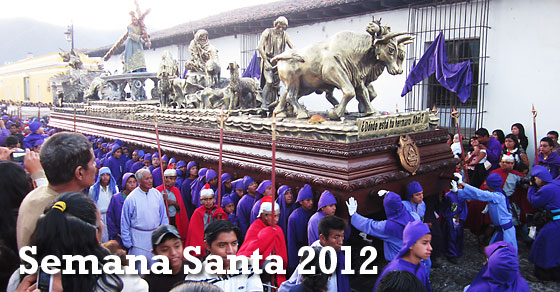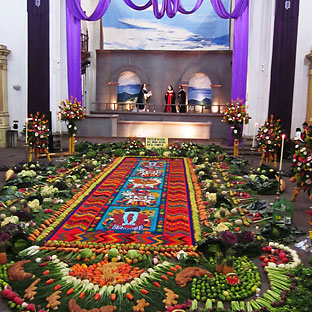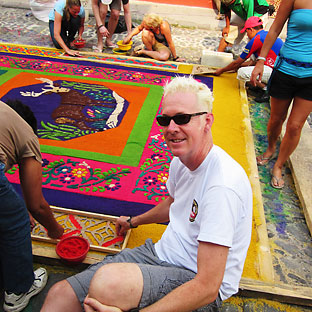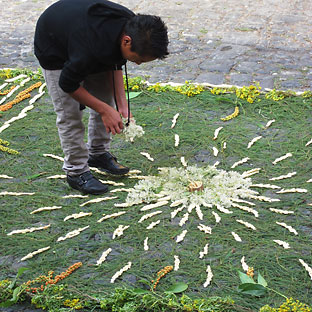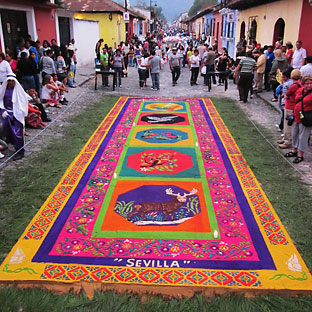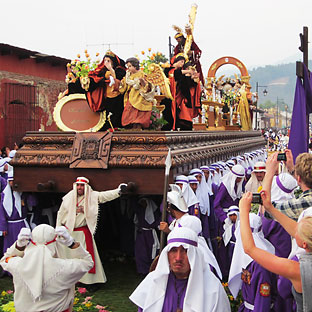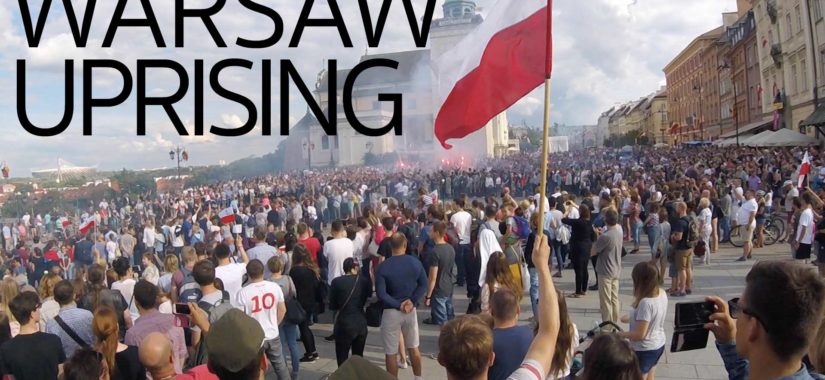Guatemala Easter Traditions
Semana Santa
Easter is commonly referred to as Semana Santa in Guatemala. The words literally translate as semana = week and santa = holy or sacred, or together they really mean ‘Holy Week’. And in Guatemala this term means the week prior to and including Easter, but also is loosely used to define the six weeks (about 40 days) prior to Easter (also known as Lent). Beyond the normal church meetings you might expect, there are three different notable activities that tourists find interesting–activities the locals are quite obsessed with. These activities include decorative carpets and biblical scenes in churches, decorative carpets in the streets and processions. I’ll do my best to explain them in this article.
Church Display (one day prior to a procession)
Processions, which will be described below, typically depart from one church or cathedral, travel several hours over a distance, around a central park, and then arrive hours later at a different church or cathedral. That said, one day prior to a procession, the church hosting the departure will typically clear most of the front of the church for an elaborate display called a velacion which consists of two parts. The entire back wall of the church will hold a large nativity style display from a famous passage in the Bible (it’s not a nativity per se because it doesn’t have to be about the birth of Jesus, but it is a lot like a nativity in that it consists of various Biblical characters depicting some Biblical event). In it’s simplest form this can be a large mural canvas, but more complex displays create a life size depiction of a Biblical story complete with life size mannequins.
Decorative Carpets (Alfombras)
The second part of the display is an elaborate colored carpet on the floor, usually made of colored sand and sawdust in conjunction with fruits and vegetables (which remind me of pagan offerings to gods).
There are two kinds of carpets. Simple, inexpensive carpets are made by local families from pine needles, flowers, vegetables and corozo, a large pod, which upon being opened, yields hundreds of sticky yellow strands. Both the pod and the strands are used in the alfombras.
The more elaborate, and expensive, carpets are made of colored sawdust. Sawdust colored carpets can cost between 5,000q to 10,000q ($600 to $1200). To give you some idea of the relative cost, that is like four to six months salary for an average Guatemalan; they earns about $40 a week. It usually take takes a day or so to add dye to the raw sawdust in the various colors. Then, the actual construction of the carpet takes several hours. The carpet my Spanish school constructed took about eight hours to build from start to finish with about a dozen people working on it at any given time (rotating in shifts). In brief, the first step is to create a side frame around the edges of the carpet and to lay down a flat layer of sawdust (because the roads here are made of up of colonial paving stones). Once they have a flat base layer they use elevated thick boards on cider blocks to access the middle area. They start with by putting down a layer of the base color. Over the based color, they then use a masonite stencil pattern and fill the pattern with small areas of colored sawdust. When the stencil is lifted the colored sawdust remains creating the intricate patterns. They work from the middle outward laying down base colors and using stencils for the designs. It is really amazing to see. Especially when hours of work is destroyed in minutes as the procession passes over the carpet.
Processions
Each Semana Santa procession starts out with lines of cucuruchos (guys who carry the float), who often walk with the procession, even once their turn is over. Children with incense walk in between these lines and men with special poles to lift the power lines as the float passes come along, as well. There is usually a banner for the hermandad that is putting on the Semana Santa procession.
Following these is the float with Jesus Christ, the largest float. This is carried only by men. Behind this is the men’s band, playing funeral marches, then the women’s float, with the Virgin Mary and the women’s band (comprised of men) behind this.
To keep the way clear for the floats and the bands, men walk beside them, on the edge of the street, holding a length of thick rope that runs along the side of the Semana Santa procession and keeps the crowds outside the processional area.
The floats (in Spanish they care called andas) for the processions are usually very large. They are built of wood, with carrying handles on either side for the cucuruchos to lift. Often, these floats have detailed carvings of flowers and birds, as well as scrollwork along the edges, making them even more beautiful. These are just the bases however, the real art takes place on top.
Float designs change each and every year. While the figures remain the same (albeit with new clothing most of the time), the scenes in which they are placed are very different. The actual stage can be several feet tall, with fake boulders, cellophane waterfalls and even bushes and trees around the main characters. It takes the entire year to plan and create these beautiful scenes and the bigger the float, the more elaborate the design. Much of the decor on top is styrofoam or fiberglass to keep the weight down.
Lights are usually incorporated into the floats, since processions continue late into the night and even into the early morning hours, if they fall behind, which is common. These are run by generators which are wheeled behind each anda, tended by at least one or two men. This means the Semana Santa procession is also accompanied by the drone of the generator whenever the band stops playing.
There is at least one or two processions in Antigua during the six weeks prior to the holy week. Then, during Semana Santa, there is at least one or two processions each day leading up to Thursday. On Thursday there are four procession in the same day. On Thursday night Guatemalans dress as Roman soldiers and travel the entire night on horseback going up and down all the streets shouting out the Roman proclamation that Pilot has judged Jesus and sentenced him to die by crucifixion on Friday. On Friday there are three or four more processions and a reenactment of the crucifixion in from of the Cathedral at central park. The processions continue all day and into the night. Saturday most of the people leave and there are only two processions as the Semana Santa ends. Sunday there are no processions and most people are recovering from the week. It seems some people go to Church that day, but many of the others are so exhausted they mostly relax and take naps while watching TV or reading. From what I could tell the activities of Thursday and Friday are the main focus of religious activities and Easter Sunday has very little importance in comparison.
Overall I found the Semana Santa activities fascinating to see; I highly recommend if you ever have a chance to visit Antigua and experience Semana Santa, this is one event you won’t want to miss.

